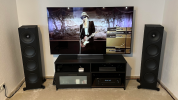Hi,
I'm a newbie in the acoustics world, just started discovering everything and experimenting. For now, I have Denon 3800 with Audyssey XT32 and 2 tower speakers. Central speaker and a subwoofer are on the way, so I will redo the experiments below when they arrive. Also ordered UMIK-1 for REW and Dirac.
I have an irregularly shaped room (see the picture) and the following measurement taken with the Audyssey app, visualized in Ratbuddyssey (don't have the mic for REW yet). I took the measurement several times, so it should be correct. It shows a huge spike around 70 Hz and sever decline after 2kHz. I tried to move speakers out of the corners, tried several positions with no real difference until I move them completely out of the niche. The 2nd picture shows the measurement with the speaker placed at the room center, and it looks fine, I think.
I hope the room can be corrected with either Audyssey or Dirac, but what else can / should be done (some kind of room treatment, I guess) to help them? Because the 1st measurement looks pretty bad. Placing speakers not in the niche is the last option I would try, only if the room cannot be corrected.
Thanks.
The room:

Speakers in the niche, before correction:

Speakers out of the niche, before correction:

I'm a newbie in the acoustics world, just started discovering everything and experimenting. For now, I have Denon 3800 with Audyssey XT32 and 2 tower speakers. Central speaker and a subwoofer are on the way, so I will redo the experiments below when they arrive. Also ordered UMIK-1 for REW and Dirac.
I have an irregularly shaped room (see the picture) and the following measurement taken with the Audyssey app, visualized in Ratbuddyssey (don't have the mic for REW yet). I took the measurement several times, so it should be correct. It shows a huge spike around 70 Hz and sever decline after 2kHz. I tried to move speakers out of the corners, tried several positions with no real difference until I move them completely out of the niche. The 2nd picture shows the measurement with the speaker placed at the room center, and it looks fine, I think.
I hope the room can be corrected with either Audyssey or Dirac, but what else can / should be done (some kind of room treatment, I guess) to help them? Because the 1st measurement looks pretty bad. Placing speakers not in the niche is the last option I would try, only if the room cannot be corrected.
Thanks.
The room:
Speakers in the niche, before correction:
Speakers out of the niche, before correction:

